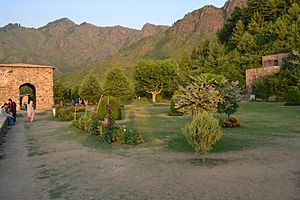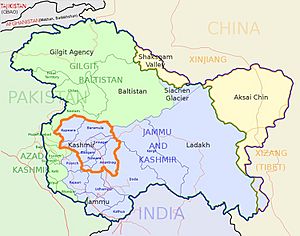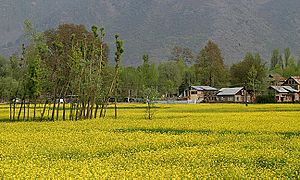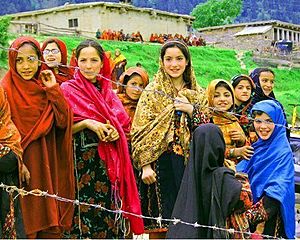Kashmir Valley
Quick facts for kids
Kashmir Valley
وادی کشمیر
कश्मीर घाटी Vale of Kashmir
|
|
|---|---|
|
State division
|
|

Group of arched terraces and structural complex
|
|

Kashmir Valley (orange bordered) lies in Jammu & Kashmir state of India
|
|
| Countries | India/Pakistan |
| Division | Jammu and Kashmir |
| Districts | Anantnag, Baramulla, Budgam, Bandipore, Ganderbal, Kupwara, Kulgam, Pulwama, Shopian and Srinagar |
| Headquarters | Srinagar |
| Area | |
| • Total | 15,948 km2 (6,158 sq mi) |
| Elevation | 1,850 m (6,070 ft) |
| Population
(2011)
|
|
| • Total | 6,907,622 |
| • Density | 433.134/km2 (1,121.81/sq mi) |
| Demonym(s) | Kashmiri, Koshur (in Kashmiri) |
| Languages | |
| • Official, Main spoken language | Urdu Kashmiri |
| Time zone | UTC+5:30 (IST) |
The Kashmir Valley is a beautiful valley located between two large mountain ranges: the Karakoram and the Pir Panjal Range. Long ago, a huge lake called Karewa covered this area. Over time, the land lifted up, and the lake drained away, forming the valley we see today.
A famous ruler named Jahangir (1569–1627) from the Mughal dynasty once called the Kashmir Valley "a paradise on earth." Today, it is part of the Jammu and Kashmir state, which is controlled by India. The valley has 10 different areas, called districts. It is about 135 kilometers (84 miles) long and 32 kilometers (20 miles) wide.
Contents
What makes Kashmir Valley so beautiful?
Ancient Greeks called this valley Kaspeiria. Other old writings refer to it as Kaspatyrol. A Chinese monk named Xuanzang visited in 631 AD and called it Kia-shi-mi-lo. People from Tibet called it Khachal, which means "snowy mountain."
The Kashmir Valley is known for its many rivers, lakes, and colorful wildflowers. The Jhelum River flows through the entire valley. High, snow-capped mountains surround the valley, making it feel very private.
Lakes like Dal Lake and Nagin Lake are famous for their hundreds of houseboats. These houseboats became popular during the time of the British Raj. Back then, foreigners were not allowed to buy land in Kashmir. So, they built large wooden houseboats to enjoy their summers. This led to many houseboats becoming hotels. Many are decorated with beautiful wood carvings and old-fashioned Victorian era furniture.
Why is there a dispute in Kashmir?
After India and Pakistan became separate countries, they fought over the Kashmir region in 1947–1948. The United Nations helped them agree on a ceasefire line. This line left the Kashmir Valley under India's control.
In 1972, India and Pakistan signed a peace agreement called the Simla Agreement. They promised to solve their problems peacefully in the future. This agreement also changed the ceasefire line's name to the Line of Control.
India believes the entire state, including the Kashmir Valley, belongs to India. Countries like the United States and the United Kingdom think the Line of Control should become the official border between India and Pakistan. India seems to agree with this idea, but Pakistan does not.
India has sent many security forces to Kashmir over the years. This has made Kashmir one of the most militarized places in the world. In 1989, there was an armed uprising against India's control. India said Pakistan was supporting this uprising.
In 1999, another conflict happened. Forces supported by Pakistan entered Kashmir. Both armies have fired across the Line of Control. However, India has not sent its troops into Pakistan. Sadly, many people have been killed in Kashmir over the years.
What is the current situation?
Most people living in the Kashmir Valley are Muslim. The main way people earn money is through farming. But recently, tourism has also become a very important industry.
Neither India nor Pakistan wants a full-scale war, especially since both countries have nuclear weapons. They also want to avoid international sanctions, which would happen if a war broke out.
Who are the political groups in Kashmir?
Main political parties
- Jammu and Kashmir Democratic Freedom Party (JKDFP): This party started in 1998. They want Jammu and Kashmir to govern itself.
- Jammu and Kashmir People’s Democratic Party (PDP): Formed in 1999, this party also wants self-rule for Jammu and Kashmir. They are a separatist party.
- All Parties Hurriyat Conference (APHC): This group started in 1993. It is a group of 26 different political, social, and religious organizations in Kashmir. They want Kashmir to be ruled by Pakistan.
- Indian National Congress (INC): This is one of India's two biggest political parties. In the 2009 election, they formed a group with other parties to run the government.
- Bharatiya Janata Party (BJP): This is the second-largest party in India. It is a Hindu-National party. They were in power from 1998 to 2004.
- Jammu and Kashmir National Conference Party (NCP): This party started in 1939. For many years, it was the main party in Kashmir. They also support self-rule.
| Religions in Kashmir Valley | ||||
|---|---|---|---|---|
| Religion | Percent | |||
| Islam | 98% | |||
| Hindu, Sikh, Buddhist and others | 2% | |||
Militant groups
- Jaish-e-Mohammed: This group operates in Kashmir but is based in Pakistan. They want Kashmir to be ruled by Pakistan. Pakistan banned this group in 2002, but they still operate.
- Hizb-ul-Mujahideen: This is another militant group that has been active in Kashmir since 1989.
- Lashkar-e-Taiba: This group has been responsible for several violent attacks, including attacks in Delhi in 2000. India believes they were also involved in the 2009 Mumbai attacks. Many members of this group are not from Kashmir. They operate in Kashmir but are based in Pakistan.
See also
 In Spanish: Valle de Cachemira para niños
In Spanish: Valle de Cachemira para niños



